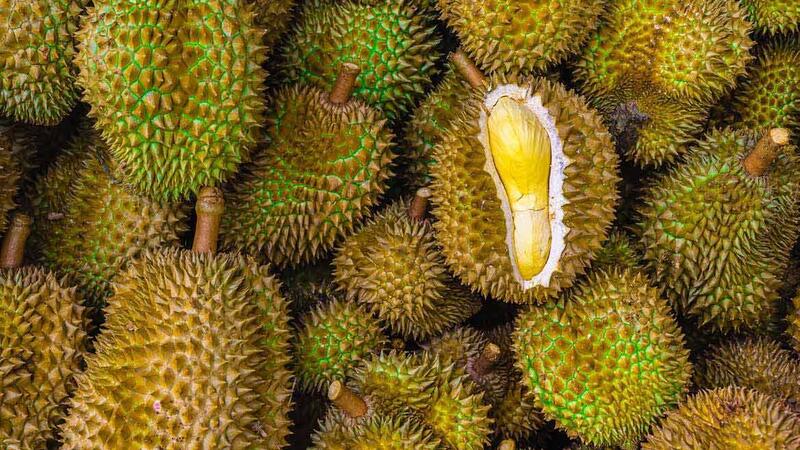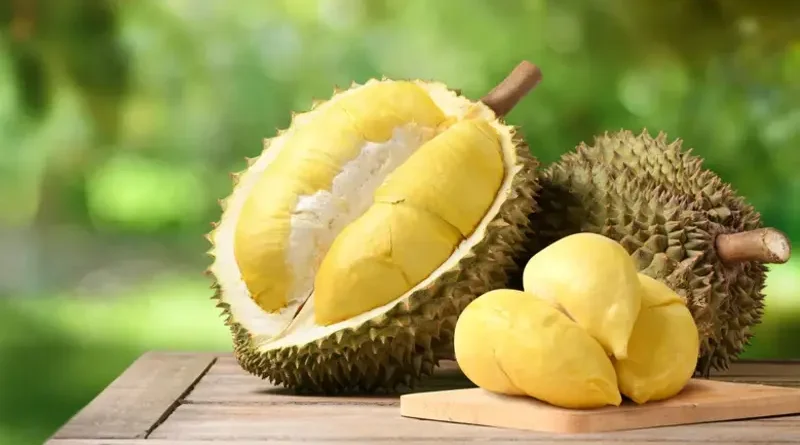The Complete Guide of Durian Fruit
Welcome to the world of durian fruit, a well-known tropical treat with a long history. Known as the “king of fruits” in Southeast Asia, durians have captured the attention of locals and foodies throughout the world with their unique flavor, scent, and jagged skin. This article explores the debates, culinary applications, and nutritional advantages of this divisive fruit. Get ready to learn why the durian is more than simply a fruit—it’s a cultural symbol that ignites debates and feelings all around the world.
Physical Characteristics and Durian Fruit Varieties
The spiky husk of the durian, which is known for its unique appearance, encases creamy, sweet meat. Taste, texture, and perfume vary throughout varieties, with well-known varieties such as Musang King and Monthong providing distinct sensory experiences. Gaining an appreciation of the physical characteristics and variety of durian fruits improves one’s understanding of their culinary potential and cultural importance.
Nutritional Content and Durian Fruit Health Benefits
Durian is known for being a high-calorie treat, but it has a surprisingly wide range of nutritional advantages. Here’s a closer look at this exotic fruit’s nutritional value and health benefits:
Nutritional Profile
The fruit durian is high in nutrients and contains a lot of fiber, good fats, healthy carbs, and vitamins and minerals. About 100 grams, or one serving, of durian typically comprises the following:
| Nutrition | Facts |
|---|---|
| Calories | 357 |
| Fat | 13 grams |
| Carbs | 66 grams |
| Fiber | 9 grams |
| Protein | 4 grams |
| Vitamin C | 80% of the Daily Value |
| Thiamine | 61% of the Daily Value |
| Manganese | 39% of the Daily Value |
| Vitamin B6 | 38% of the Daily Value |
| Potassium | 30% of the Daily Value |
| Riboflavin | 29% of the Daily Value |
| Copper | 25% of the Daily Value |
| Folate | 22% of the Daily Value |
| Magnesium | 18% of the Daily Value |
| Niacin | 13% of the Daily Value |
Durian Fruit Health Benefits
Heart Health:
Due to its potassium content, durian lowers the risk of cardiovascular disease and hypertension by regulating blood pressure.
Digestive Health:
Dietary fiber, which helps with digestion, encourages regular bowel movements, and wards off constipation, is abundant in durian.
Immune Support:
Durian helps the body fend against infections and illnesses by boosting immunity due to its high vitamin C concentration.
Energy Boost:
Because durian has a high amount of carbohydrates, it is a great food for refueling your body after strenuous activity.
Bone Health:
Due to the calcium and phosphorus content of durian, there is a decreased risk of osteoporosis and fractures by increasing bone strength and density.
Skin Health:
The manufacturing of collagen is greatly aided by vitamin C, which also promotes skin suppleness and wound healing, all of which contribute to healthy, glowing skin.
Unique Taste Profile and Aroma
The divisive taste profile and strong scent of durian are among its most distinctive characteristics. Let’s examine why people who come into contact with this fruit either adore it or detest it:

Taste Profile
It can be difficult to describe the taste of durian because it has a distinct flavor profile that varies based on the kind and ripeness of the fruit. Several commonly used adjectives to describe the flavor of durian include:
Sweet:
Natural sugars found in durian’s creamy flesh give it a delicate sweetness akin to custard or caramel.
Bitter:
There may be overtones of bitterness in some durian cultivars, which gives the overall flavor profile more depth and complexity.
Savory:
Durian’s delicious appeal is attributed to the fact that some people compare its flavor to that of onions, garlic, or even roasted almonds.
Creamy:
Rich, velvety, and melt-in-your-mouth creamy textures characterize durian flesh, adding to its decadent appeal.
Durian Fruit Aroma
The strongest, most offensive feature of durian is undoubtedly its intense, pungent scent, which has made it known as the “world’s smelliest fruit.” Durian smells a lot like rotten onions mixed with turpentine and sweaty socks, with a tinge of sweetness and earthiness. For those who are familiar with the fruit, this particular perfume can cling to the air for hours at a time.
Culinary Uses and Traditional Recipes
Due to its distinct flavor and creamy texture, durian can be used in a variety of savory and sweet recipes. Let’s look at some traditional durian recipes and culinary applications:
1. Desserts
Durian Sticky Rice:
This is a well-known Thai delicacy that makes a rich and decadent treat by cooking glutinous rice in coconut milk with ripe durian flesh.
Durian Ice Cream:
A popular delicacy in many Southeast Asian nations, durian ice cream is rich and creamy, providing a cool way to savor the unique flavor of the fruit.
Durian Pancakes:
A delectable snack or dessert favored in Malaysia and Singapore, thin pancakes filled with durian paste have the ideal amount of sweetness and creaminess.
2. Beverages
Durian Smoothie:
Smoothies made from blended milk or yogurt with a hint of honey are a creamy and filling way to savor the flavor of durian while getting a nutritional boost.
Durian Milkshake:
For fans of durian, durian milkshakes, which combine durian pulp with ice cream and milk, provide a rich and cool beverage choice.
3. Savory Dishes
Durian Curry:
Durian lends a creamy smoothness and delicate sweetness to savory curries that are popular in Malaysia and Thailand. It goes nicely with coconut milk, spicy spices, and meats like chicken, steak, or shellfish.
Durian Fried Rice:
A tasty and filling lunch or dinner can be made with stir-fried rice, durian, veggies, and your preferred protein.
4. Snacks and Appetizers
Durian Spring Rolls:
Served as an appetizer or snack, crispy spring rolls packed with shredded coconut and durian present a delicious blend of flavors and textures.
Durian Puffs:
A popular dish in bakeries and dessert shops in Southeast Asia, light and airy pastry puffs filled with durian cream provide a sweet and creamy pleasure.
Conclusion
In summary, durian fruit represents more than simply a tropical treat; it is a cultural symbol that arouses discussions and stokes emotions all over the world. It enhances culinary experiences across a variety of cuisines with its unique flavor, aroma, and nutritional advantages that make it a versatile ingredient in both sweet and savory meals.
Despite its divisive character, durian is still associated with luxury and provides daring foodies with an unforgettable sensory experience. Loved or hated, the “king of fruits” has a lasting effect that makes us understand its complexity and cultural significance in the culinary arts.
You Can Read More About Health Benefits
Discover the Powerful Health Benefits of Oranges
Health Benefits of Emmer Wheat You Should Know
